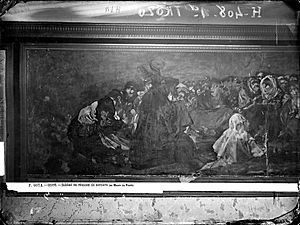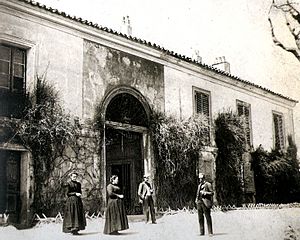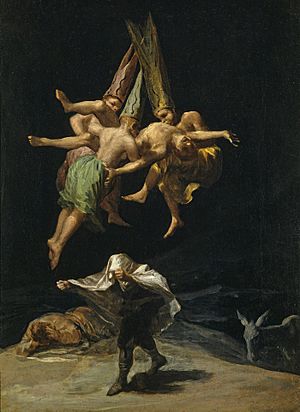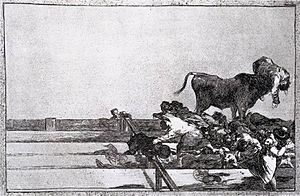Witches' Sabbath (The Great He-Goat) facts for kids
Quick facts for kids Witches' Sabbath (The Great He-Goat) |
|
|---|---|

Witches' Sabbath, 1821–1823. Oil on plaster wall, transferred to canvas; 140.5 × 435.7 cm (56 × 172 in). Museo del Prado, Madrid
|
|
| Artist | Francisco Goya |
| Year | c. 1821-1823 |
| Medium | Oil mural |
Witches' Sabbath or The Great He-Goat (Spanish: Aquelarre or El gran cabrón) is a famous oil mural by the Spanish artist Francisco Goya. He finished it between 1821 and 1823. This painting shows ideas about fear, growing old, and death. It features Satan looking like a huge goat in the moonlight, standing over a group of scared witches. Goya was about 75 years old when he painted this, living alone, and dealing with serious health issues.
This painting is one of fourteen Black Paintings. Goya painted these directly onto the plaster walls of his house, called the Quinta del Sordo. He kept these paintings a secret and never gave them titles or explained why he made them. Many art experts believe Witches' Sabbath makes fun of how easily people believed strange things back then. It also criticizes superstition and the witch trials of the Spanish Inquisition. Like his other Black Paintings, this work shows Goya's disappointment with the world. It connects to his earlier works, like The Sleep of Reason Produces Monsters and the Disasters of War prints, which were strong political statements.
Around 1874, about 50 years after Goya died, the paintings were carefully moved from the walls to canvas. Witches' Sabbath was originally much wider. About 140 centimeters (56 inches) were cut from the right side during this process. Now, at 141 × 436 cm (56 × 172 in), some people think its tight framing makes it look more spooky. Others believe it changed Goya's original idea.
Contents
Understanding Goya's Black Paintings
Goya did not name any of his 14 Black Paintings. The names we use today were given after he died, mostly by his children and a close friend around the 1860s. For example, the name El Gran Cabrón (The Great He-Goat) was given by painter Antonio Brugada. The Spanish title Aquelarre comes from the Basque language word for a Witches' Sabbath, which means "field of the male goat."
We don't know much about Goya's thoughts during his later years. He kept many of his works from this time private, like the Disasters of War series, which are now considered some of his best. Goya was worried about getting old and losing his mind, possibly due to an illness that made him deaf in the 1790s. He had been a successful artist for the royal family but chose to live a quiet life in his final years. From the late 1810s, he lived almost alone in a farmhouse outside Madrid. This house became known as "the House of the Deaf Man" (la Quinta del Sordo).
Art experts believe Goya felt out of place with the changes happening in Spain after the king returned to power in 1814. He saw these changes as a step backward, especially in politics and religion. He had hoped for reforms but was disappointed when the king and the Catholic hierarchy rejected the Spanish Constitution of 1812.
Goya moved to France in 1824. His grandson, Mariano, then owned the house. Records from 1830 show that Witches' Sabbath covered a whole wall on the first floor, opposite A Pilgrimage to San Isidro. Other Black Paintings like Saturn Devouring His Son and Judith and Holofernes were nearby. The paintings were in bad shape after many years on the walls. To save them, the new owner had them moved to canvas by art restorer Salvador Martínez Cubells. After being shown in Paris in 1878, they were given to the Spanish government in 1881.
What the Painting Shows
In the painting, Satan is shown as a goat-like figure with horns and a beard, standing on a raised mound. He looks like he's screaming, and his dark shape stands out against the moonlit sky. He might be based on an old drawing of a god named Moloch.
Satan is surrounded by a group of women, who are believed to be a coven of witches. Most of them are crouched and look terrified, while others stare at him with awe. Art experts describe the women as looking almost animal-like and scared. Satan's power over them seems to come from fear, not respect. The women are a mix of old and young, with twisted, nervous faces. Goya used dark and light colors to create a spooky mood, similar to how artists like Velázquez and Jusepe de Ribera used light and shadow.
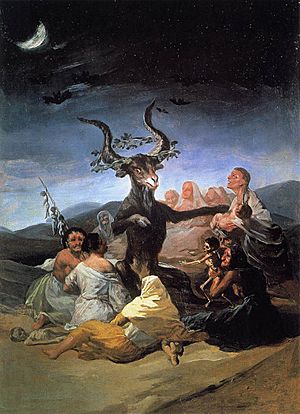
An old woman sits to the right of the goat, with her back to us. Her face is partly hidden, and she wears a white hood like a nun's. She sits near bottles and vials. The faces of some figures have white lines around their eyes. The goat's face and the old woman's face are hidden. This woman is separate from the group, perhaps about to join the witches. She might be Leocadia Weiss, Goya's maid and possible partner, whose portrait is also in the Black Paintings series.
Like his other Black Paintings, Goya started with a black background and then added lighter colors. He used thick, strong brushstrokes of gray, blue, and brown. The darkest parts of the painting, like the Devil, were made by leaving the black background showing through. The painting was done directly onto the wall, unlike some of his other Black Paintings which had drawings first.
Some art experts say Goya's brushwork in this painting looks "clumsy" or "rough" compared to his earlier, more detailed work. They think this was on purpose, to show his feelings of doubt and sadness about human weaknesses. Witches' Sabbath is special because Goya didn't change it much after he first painted it.
Restoration of the Painting
Between 1874 and 1878, the restorer Salvador Martinez Cubells worked on the painting. He touched up the goat's horns and some of the witches' faces. He also removed more than 140 centimeters (56 inches) of landscape and sky from the right side of the painting. This part was badly damaged. This change moved the main focus of the painting, making the young woman on the right less central.
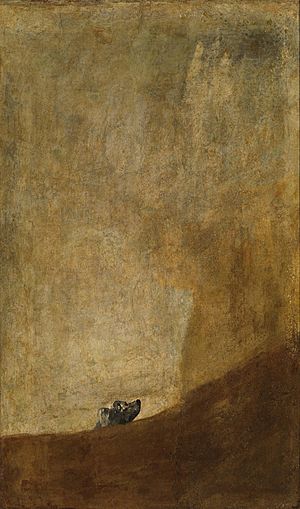
Some art experts think the removed part was too damaged to save. However, it's also possible it was cut for artistic reasons, as the empty space on the right might have seemed unnecessary. If this was the reason, it was a mistake. Goya often used empty space to create powerful and emotional effects, as seen in The Dog from the same series. He liked to challenge common ideas about balance in art.
Condition of the Painting
The painting is not in good condition today. Over time, and because of the difficult process of moving it from plaster to canvas, it has suffered a lot of damage and lost much of its paint. It seems the painting was already badly damaged even before it was taken off Goya's walls. Painting with oil on dry plaster, as Goya did, can cause the artwork to break down over time.
Many of the Black Paintings were changed quite a bit during the restoration in the 1870s. One critic said that the paintings in the Prado Museum today are "at best a crude copy" of what Goya originally painted. We know about some of the changes from the restorer's own notes, but these might not be completely fair. More reliable are two old photographs taken by Jean Laurent in 1874, before the restoration. These photos show the painting still on the wall in Goya's house and give us the best idea of how it looked originally. However, these old photos also have some unclear parts and can change how colors appear.
Images for kids
See also
 In Spanish: El aquelarre (1823) para niños
In Spanish: El aquelarre (1823) para niños


